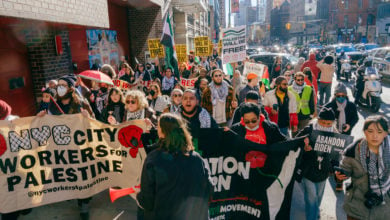 Airline workers protest outside the bankruptcy hearing of United Airlines. Photo: Reuters/Stephen J. Carrera |
United cried to the judges that fulfilling their obligations would hurt their ability to make a profit. The court agreed. In the months leading up to the decision, United had used the threat of the bankruptcy court to force wage and benefit cuts on union machinists and mechanics.
United Airlines workers are not the only airline workers under attack. On May 13, a week after the union workers rejected a contract calling for severe wage and benefit cuts, Alaska Airlines fired 472 baggage handlers at the Seattle airport. These workers’ average wage was $15.38 an hour, but their jobs have now been outsourced, replaced by Menzies Aviators’ non-union workers. Menzies offers a mere $8.50 an hour. The same week Alaska Airlines pilots accepted a 20 percent wage and benefit cut.
All of the “Big Six” airlines—American, United, Delta, Northwest, Continental and U.S. Airways—have demanded and won big pay, benefit and job cuts since 2000. Over 100,000 wage-labor jobs have been eliminated, amounting to a more than 25 percent reduction.
The airlines blame the current round of cuts on the high price of oil. Before the spike in fuel prices, their excuse was Sept. 11. Before Sept. 11, they justified their cuts by citing increased competition with new, non-union airlines like Jet Blue. But the avalanche of cutbacks, which have wiped out the livelihoods and pensions of tens of thousands of workers, began much earlier.
Deregulation and the ‘free market’
In 1978, Congress passed the Airline Deregulation Act. Democratic President Jimmy Carter signed it into law. This Act initiated the process of federal deregulation of air routes, airfares and industry rates of profit. Carter also signed a follow-up International Air Transportation Competition Act in 1980, which gradually removed various regulations. The federal regulatory agency, called the Civil Aeronautics Board, was ultimately disbanded in 1984.
The airline bosses argued that the free market, rather than a regulatory board, was more capable of ruling the industry. They claimed competition would build stronger airline companies, improve service and safety and benefit travelers.
The opposite has happened. Two of the “Big Six”, United and U.S. Airways, are bankrupt. Delta is teetering on the edge. At the end of last year, during the holiday travel crunch, U.S. Airways was unable to manage all its passengers. They canceled hundreds of flights and lost thousands of bags. The company blamed the workers, claiming they had all conspired to call in sick. In fact, the system crashed as a result of the cutbacks and the unrealistic speed-up demands on baggage handlers.
While the airline industry sold deregulation to the public as a means to benefit consumers, in 1981 Ronald Reagan revealed the true nature of deregulation. He fired and then banned members of the Professional Air Traffic Controllers Organization from further federal employment. These highly trained and relatively high-paid union workers were replaced with a lower paid, non-union work force. The race to the bottom had begun.
Corporations and their government backers view government regulation as a question of economic expediency—of how best to make profit. When the airline industry first began, it sought federal control and regulation. It fought for the Air Commerce Act of 1926, which authorized the Department of Commerce to issue and enforce air traffic rules, to license pilots, certify aircraft and to maintain guides and infrastructure to aid navigation.
In that initial period, government regulation benefited the airline bosses and secured their profits. Fifty years later, the industry had fully developed and become an indispensable feature of modern society. At that point, regulation—since it included a role for the airline workers—stood in the way of fully maximized profits.
The federal government built and currently runs the air traffic control system, paid for by working peoples’ taxes. Local public entities built the airports, also paid for by workers. The airspace itself is public. Yet all the profits are private.
 Flight attendants demand their pensions. Photo: Stringer/USA |
Despite the cutbacks, layoffs and courtroom deals, the workers are fighting back. United’s flight attendants have promised what they call CHAOS (Create Havoc Across Our System). CHAOS is a campaign of strategic job actions, like unannounced one-day or half-day strikes or a sudden strike of one particular airport or route. The airline is stretched so thin with staff cuts and speed-ups that the flight attendants claim a 15-minute strike could cause the entire system to crash.
Innovative new strategies like CHAOS are necessary not just for airline workers but all organized workers. As the CHAOS tactic is tried and tested, labor activists will be watching.






